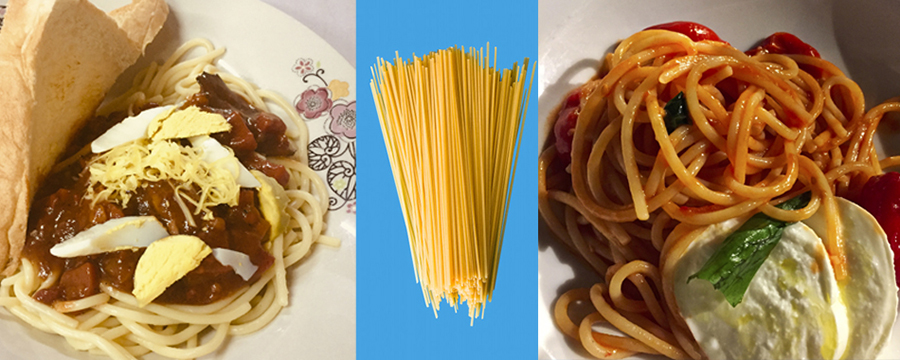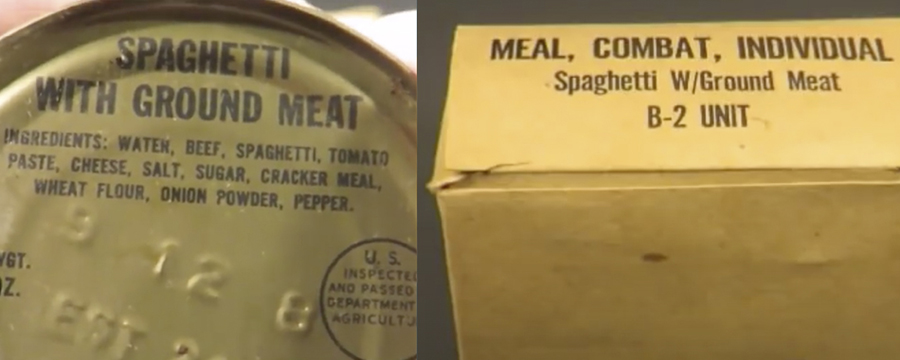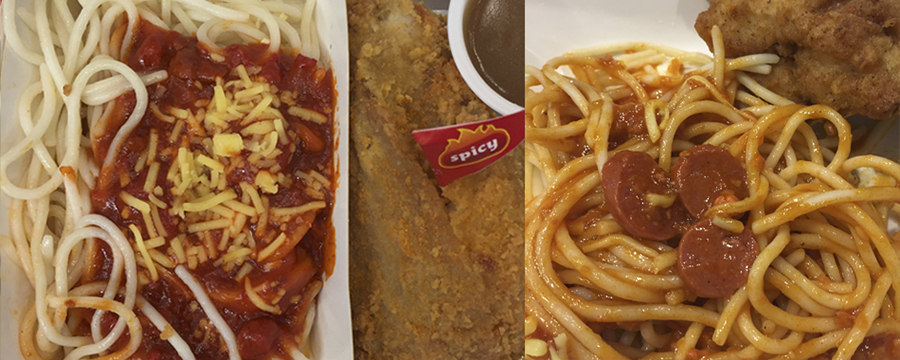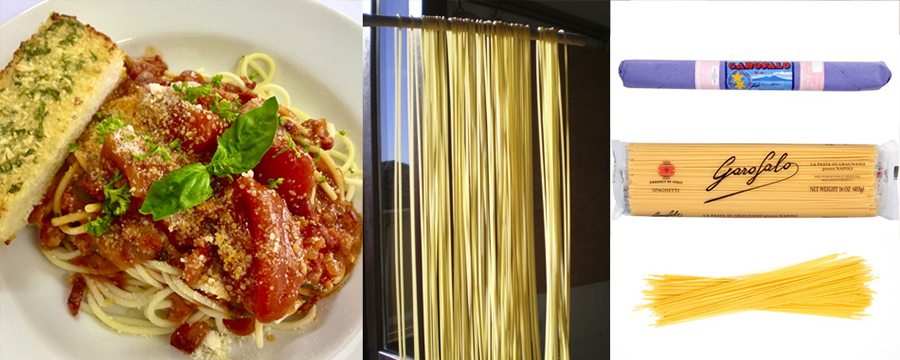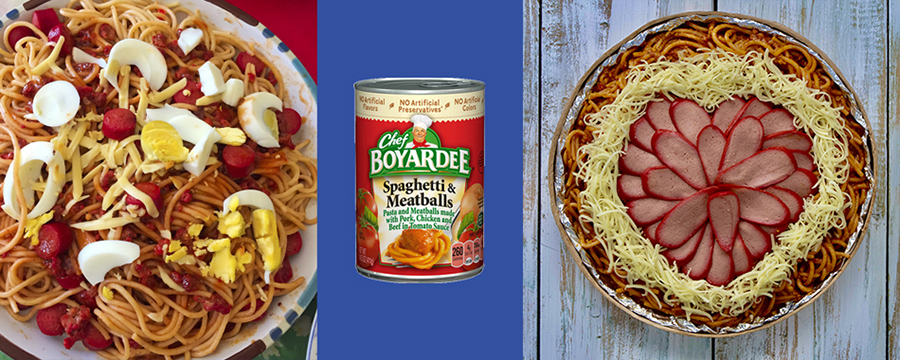The strange tale of how the sweet spaghetti became a Filipino cultural icon | ABS-CBN

Welcome, Kapamilya! We use cookies to improve your browsing experience. Continuing to use this site means you agree to our use of cookies. Tell me more!
The strange tale of how the sweet spaghetti became a Filipino cultural icon
The strange tale of how the sweet spaghetti became a Filipino cultural icon
ANCX
Published May 10, 2020 11:13 AM PHT
|
Updated May 10, 2020 12:08 PM PHT
Perhaps, 75 years ago or more, it so happened that a classic European dish made a detour to the Philippines, after which it underwent such severe mutation that the original creators would no longer recognize it.
Perhaps, 75 years ago or more, it so happened that a classic European dish made a detour to the Philippines, after which it underwent such severe mutation that the original creators would no longer recognize it.
Of course, I’m talking about spaghetti, Italy’s greatest culinary export after pizza. The phenomenon is called cultural morphing, in which an object is morphed into something unique and becomes a cultural artefact of another country, caused either by colonization or globalization.
Of course, I’m talking about spaghetti, Italy’s greatest culinary export after pizza. The phenomenon is called cultural morphing, in which an object is morphed into something unique and becomes a cultural artefact of another country, caused either by colonization or globalization.
You may also like:
You may also like:
By polarizing and dividing people’s opinion, it has since become a somewhat subversive symbol of how we embraced this culinary anomaly as our own. Love it or hate it, the Filipino sweet spaghetti has become a cultural icon.
By polarizing and dividing people’s opinion, it has since become a somewhat subversive symbol of how we embraced this culinary anomaly as our own. Love it or hate it, the Filipino sweet spaghetti has become a cultural icon.
My earliest memory of sweet spaghetti with ground meat goes back to 1969 when papa would bring home cans of C Ration MCI or Meal Combat Individual in distinctive olive green cans emblazoned with black sans serif lettering that came with its own PHP 38 can opener. My dad worked in Sangley Point driving an 18-wheeler trailer that carried the aviation gas. The goodies came from the pilots of fighter jets and freighter aircraft that flew in from Saigon en route to Clark.
My earliest memory of sweet spaghetti with ground meat goes back to 1969 when papa would bring home cans of C Ration MCI or Meal Combat Individual in distinctive olive green cans emblazoned with black sans serif lettering that came with its own PHP 38 can opener. My dad worked in Sangley Point driving an 18-wheeler trailer that carried the aviation gas. The goodies came from the pilots of fighter jets and freighter aircraft that flew in from Saigon en route to Clark.
ADVERTISEMENT
The Filipino sweet spaghetti is also an exercise in culinary decolonization, and given that each multinational fast food outlet has its own version, it is an allegory of our political and social aspirations. There is undoubtedly a cultural divide when it comes to its appreciation, as many see it as a luxury treat while others might look down on it as a culinary abomination.
The Filipino sweet spaghetti is also an exercise in culinary decolonization, and given that each multinational fast food outlet has its own version, it is an allegory of our political and social aspirations. There is undoubtedly a cultural divide when it comes to its appreciation, as many see it as a luxury treat while others might look down on it as a culinary abomination.
It was 1979 when the popular Jollibee Company first introduced special spaghetti on its menu, and now, 41 years later, parents, having been reared on sweet spaghetti, they themselves are treating their own children to the same dish.
It was 1979 when the popular Jollibee Company first introduced special spaghetti on its menu, and now, 41 years later, parents, having been reared on sweet spaghetti, they themselves are treating their own children to the same dish.
While McDonalds would never consider serving McSpaghetti in its outlets in Italy, in the Philippines, the spaghetti is in a neck-to-neck race in terms of revenue with its flagship product, the hamburger.
While McDonalds would never consider serving McSpaghetti in its outlets in Italy, in the Philippines, the spaghetti is in a neck-to-neck race in terms of revenue with its flagship product, the hamburger.
Because the basic ingredients: pasta, sweet tomato sauce, banana ketchup, hotdog, and processed cheese are present in so many Filipino families’ pantries, it has become our crisis, comfort, and celebratory food all rolled into one. Accessibility is the key. It was the substitution for the ingredients that made it work for the Filipino palate accustomed to a particular taste profile.
Because the basic ingredients: pasta, sweet tomato sauce, banana ketchup, hotdog, and processed cheese are present in so many Filipino families’ pantries, it has become our crisis, comfort, and celebratory food all rolled into one. Accessibility is the key. It was the substitution for the ingredients that made it work for the Filipino palate accustomed to a particular taste profile.
Let’s start with the pasta. In the Italian classic cookbook Il cucchiaio d’argento, the term “spaghetti” means “small strings,” ranging in length from 10 to 16 inches. It should possess an amber yellow color with a shiny surface and should never be cut into pieces prior to cooking or overcooked to the point of becoming bloated. Italians describe this as “al dente” or “to the bite.” For the average Filipino, however, al dente means undercooked or hindi pa luto. Instead, it should be bloated, fat, short, and starchy.
Let’s start with the pasta. In the Italian classic cookbook Il cucchiaio d’argento, the term “spaghetti” means “small strings,” ranging in length from 10 to 16 inches. It should possess an amber yellow color with a shiny surface and should never be cut into pieces prior to cooking or overcooked to the point of becoming bloated. Italians describe this as “al dente” or “to the bite.” For the average Filipino, however, al dente means undercooked or hindi pa luto. Instead, it should be bloated, fat, short, and starchy.
According to Italian law, only durum wheat semolina flour should be used for making spaghetti, but most brands in the Philippines are made from soft wheat flour that can withstand overcooking.
According to Italian law, only durum wheat semolina flour should be used for making spaghetti, but most brands in the Philippines are made from soft wheat flour that can withstand overcooking.
To describe the Filipino spaghetti sauce as Bolognese is incorrect. This tomato-based sauce is called ragù and in fact should only be served with tagliatelle. With its ingredients of ground pork sautéed in garlic, onion, and chopped carrots, braised with evaporated milk and sweet tomato sauce, finished with banana ketchup and for good measure, sliced red hotdogs, the Filipino version is far removed from the original.
To describe the Filipino spaghetti sauce as Bolognese is incorrect. This tomato-based sauce is called ragù and in fact should only be served with tagliatelle. With its ingredients of ground pork sautéed in garlic, onion, and chopped carrots, braised with evaporated milk and sweet tomato sauce, finished with banana ketchup and for good measure, sliced red hotdogs, the Filipino version is far removed from the original.
This penchant for creamy, sweet spaghetti is a direct result of its canned pedigree from the GI rations and the brand Chef Boyardee Spaghetti with Meatballs, that was always present in the PX section of the Cartimar and Cash and Carry of the 1970s and 80s. For a time, Lady’s Choice produced its own canned version, and as a child, my Mom used this as sandwich filling.
This penchant for creamy, sweet spaghetti is a direct result of its canned pedigree from the GI rations and the brand Chef Boyardee Spaghetti with Meatballs, that was always present in the PX section of the Cartimar and Cash and Carry of the 1970s and 80s. For a time, Lady’s Choice produced its own canned version, and as a child, my Mom used this as sandwich filling.
As the workforce became younger in the Central Business District of Manila, Amber opened a hole-in-the-wall take away on Dian Street in 1988. They unapologetically embraced the Filipino sweet spaghetti phenomenon by offering an affordable bilao (bamboo tray) party-sized version for everyone to enjoy.
As the workforce became younger in the Central Business District of Manila, Amber opened a hole-in-the-wall take away on Dian Street in 1988. They unapologetically embraced the Filipino sweet spaghetti phenomenon by offering an affordable bilao (bamboo tray) party-sized version for everyone to enjoy.
There should be a deeper discourse as to how and why the Filipino sweet spaghetti came to be. For reasons of changing taste, adaptation or even war and natural calamities, chances are these are the factors that can disrupt foodways. But one thing I learned from the late food writer Doreen Fernandez, we shouldn’t ask what is Filipino food but how food becomes Filipino. So the Filipino sweet spaghetti, regardless of its provenance is as Filipino as Cardo Dalisay, Matteo Guidicelli, and Catriona Gray.
There should be a deeper discourse as to how and why the Filipino sweet spaghetti came to be. For reasons of changing taste, adaptation or even war and natural calamities, chances are these are the factors that can disrupt foodways. But one thing I learned from the late food writer Doreen Fernandez, we shouldn’t ask what is Filipino food but how food becomes Filipino. So the Filipino sweet spaghetti, regardless of its provenance is as Filipino as Cardo Dalisay, Matteo Guidicelli, and Catriona Gray.
Photos and photo collage by Ige Ramos
ADVERTISEMENT
ADVERTISEMENT


